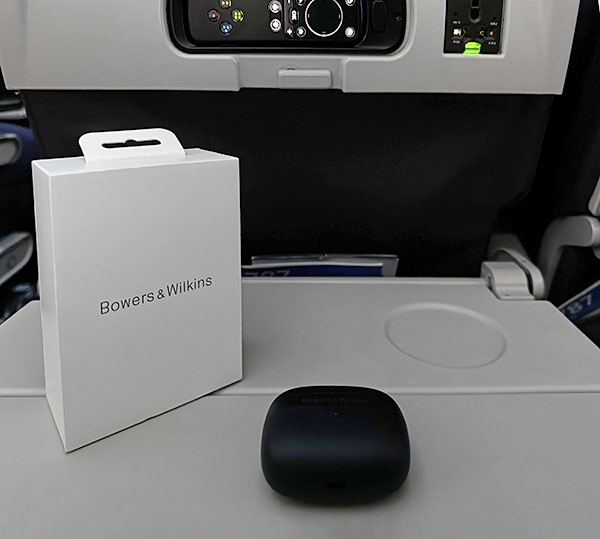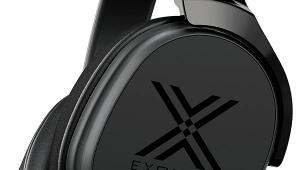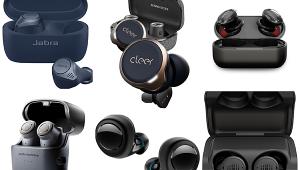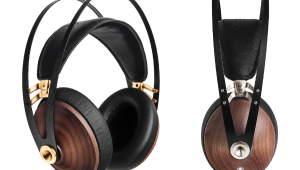Bowers & Wilkins Pi6 and Pi8 Earbuds Review: Higher Fidelity

PRICE $249 (Pi6) $399 (Pi8)
AT A GLANCE
Plus
Small and low profile
Excellent sound
Audio retransmission with case (Pi8)
Minus
Pi8 is better but more expensive
THE VERDICT
Both sets of earbuds are excellent true wireless options. But the Pi8's sound quality and features set it apart, making it an attractive upgrade even for AirPods Pro owners.
These two new true wireless earbud models from Bowers & Wilkins are updated replacements to the Pi5 S2 and Pi7 S2. While the $250/pair Pi6 could be seen as an AirPods Pro alternative based on price, the Pi8 sits well above them, a $400 flagship in-ear with a very neat trick up its sleeve carried over from the Pi7 S2: You can connect the charging case to a USB-C source and the headphones will pair directly with the case.
There are other differences between the two models that create a genuine value proposition for the pricier Pi8s, which are the primary focus of this review.
Characteristics
With all due respect to most wireless earbuds, they are a tool for a job. I'm not typically going to grab a pair when at home and I have full-size headphones or speakers to listen to. Like many others, I use them during activities including travel and work. And because of their dominance in this category, the standard to which they are compared is Apple's AirPods Pro.
So, why go with Bowers & Wilkins instead of Apple? I can think of a few reasons. The first is aesthetic, AirPods stick out of your ears, these earbuds are more discreet and are also available in black, green, blue and white. The second relates to sound, you do get a different listening experience out of the Pi6 and Pi8. It's subjective, but you might like the sound better, especially that of the Pi8, which to my ears achieves a greater level of detail rendition than Apple's. And there's choice of phone: iPhone users of course get the most out of AirPods, to the point where owning a pair to go with an iPhone is near-mandatory. But on any other device their functionality is much more limited. Meanwhile Bowers & Wilkins has an Android app, so the functionality is the same on both platforms.
Speaking of the Bowers & Wilkins Music app, it offers streaming options as well as full control over the features, including the ability to dial in a custom EQ.
With the Pi8s, the primary reason you'd get them over an alternative transcends the notion of them just being a tool. The Pi8s sound amazing, there's nothing compromising about their audio performance. And with the USB-C case connectivity, getting great sound from multiple devices without tedious re-pairing or unpredictable Bluetooth quality becomes as effortless as plugging in a pair of corded headphones. Of course, if I am going for a walk or bike ride I'll connect the pair directly to my phone. But when working on my laptop or iPad, whether at a cafe or on a plane or train, the tethered case makes a ton of sense and consistently delivers spectacular sound.
First, the Pi6. It is the more affordable model, but there are compromises. The Pi6 offers comfort, ease of use, effective noise cancellation, and a well-balanced sound signature that hits all the right spots. It uses a 12mm bio-cellulose driver and offers 8 hours of operation between charges. The highs are crisp but smooth, the mids are detailed, and the lows? Deep, rich, and textured.
The Pi6 sound is impactful without going overboard, giving you that full-bodied experience where everything feels properly in its place. If you’re the type who likes to kick back for long listening sessions—maybe with a little herbal enhancement—these will keep you floating along without a hint of fatigue. The sound is warm and inviting, yet detailed enough to keep you engaged when you want to drift off into the layers of an ambient dub track.
Now, the Pi8. Listening to Pi8s is like flipping on one of the best sound systems you’ve heard. I am not kidding. Everything just opens up. The 12mm carbon-dome drivers keep things tight, the bump in fidelity is audible. The DSP is 32-bit, vs. 24-bit in the Pi6. And aptX Bluetooth gets an upgrade from adaptive to lossless.
The bass goes deeper and hits harder, without muddying the waters. It's punchy, with a real sense of presence and an uncanny illusion of slam. The highs? Even more revealing—airy and detailed but still smooth, that perfect high where everything just makes sense. Meanwhile the mids are where these truly shine; you can practically feel the texture of vocals and guitars and can revel in the mathematical complexity of synthesized tones.
But the star of the show here is the soundstage. The both the Pi6s and Pi8s create a surprisingly lucid soundfield that feels less like earbuds and more like sitting in a meticulously tuned listening room. I did not have the sense that music was "stuck inside my head" even with stereo mixes. Instrument separation is spot-on, and you can hear those subtle sounds hanging in the air, that last bit of decay hidden in a deeply layered track. If you’re listening to something psychedelic—or really anything with lots of depth and complexity to the stereo mix—the Pi8 makes it feel like the music is swirling around you.
You'd think noise cancellation is only useful for noisy environments, but with these earbuds, thanks to their high fidelity, it serves another purpose: allowing you to hear the quietest nuances that might be masked by the typical background noise in a home. This noise, perhaps a fridge compressor combined with the faint whisper of an HVAC system, is quiet enough you usually tune it out. But it is still enough to mask fine details.
You can enjoy genuine high fidelity sound, including the requisite silence that is its foundation, with a pair of Pi6 or Pi8. So whether you’re dialing in with some classic rock or just vibing to ambient electronic tunes, these will take you on a full-blown sonic journey.
Deep Listening
For over 35 years I have pursued portable high fidelity sound because I love being outside while listening to good music. Early on in my mobile music journey, I achieved breakthrough sound quality by modifying Aiwa portable cassette players and powering them with D-cell batteries while using Grado headphones for listening. Now, even better sound is, of course, pocketable and wireless. The thrill of listening to genuine hi-fi sound on the go has not abated.
One of my favorite listens from back then was Skinny Puppy's Last Rights, a classic industrial music masterpiece of an album that will push any system to its limits. That the Pi8s can summon the heft and authority needed to do the tracks justice is a testament to their sonic prowess.
I have a particular affection for the works of Lorin Ashton, better known as Bassnectar. The man has a way with synths, creating festival-worthy anthems that happen to also be masterful exercises in mixing and production. Moreover, it is undeniably headphone music, there is no "real" soundstage to reproduce, just a fantastical world of catchy rhythms and melodies delivered with unquenchable energy, all of which comes through in spades with the Pi8s, which make the music sound straight-up electrifying. The Pi6 does an outstanding job as well, but to put it in Spinal Tap terms, they only go up to 10. The Pi8s go to 11.
In short, the Pi6 is the ideal companion for those casual, relaxed listening sessions, with its warm, well-rounded signature. But if you want to go deeper into the music—really feel it—the Pi8 is the one to transport you to another dimension.
Alas, I do not have a pricey certified calibrated headphones measurement rig. But I do have a pair of functioning ears and I like to use them to listen to deep bass sine wave tones generated by REW (room EQ wizard). I can tell if there's audible distortion or mechanical noise, I don't need a mic for that. And my verdict is the Pi8s are unbelievable at playing deep bass tones. It is so clean, the sound is a dead ringer for a high quality subwoofer. This is the case right down to 20 Hz and even below that.
The Pi6 is no slouch when it comes to the deep stuff, but with the same REW sine sweeps, while really deep tones (30 Hz and below) might even appear perceptually louder than the Pi8's bass, that is actually distortion and the sound is a lot like what I hear from other earbuds. Bottom line, the Pi6 plays very deep as well, but the Pi8s play ultra-clean and ultra-deep which is what it takes to trick your brain into thinking the bass sound is coming from outside your head.
Real Life Experiences
I took the Pi6 and Pi8 with me on a trip to England, which given the seven-hour flight is a proper torture test. I kept swapping the pair of Pi8s with my AirPods Pro and found the difference in isolation and noise canceling to be negligible. Apple's noise cancellation might have been a smidgen stronger, but not enough to care versus weighing other features and qualities.

A freshly unpacked Pi8 on the flight to England
Comfort was very similar between the Pi6, Pi8 and AirPods Pro. Battery life appears to be as advertised, I made it through each flight without even having to put the Pi8s back in the case; they had enough juice to power through the whole trip without any recharge (albeit just barely). The Pi6 has slightly longer battery life, either pair will get you across the Atlantic without even having to put them in the case for a quick charge.
One of the great torture tests for earbuds is riding in a cab or Uber in Manhattan while using the phone and listening to music. No complaints, the cancellation let me hear who's on the other end of a call and reduced noise enough to keep the music flowing without distraction. And when needed, the transparency mode made talking to the driver without taking the earbuds out easy. The touch sensitivity feature of the earbuds is responsive and intuitive.
The bottom line is the Pi8 is a compelling upgrade in portable sound. I used them for the duration of the flight, and for the trip home. I took them to NYC, wore them on AMTRAK and in Uber. Especially with the Pi8s, the comfort and fidelity and effective noise cancellation certainly hit a sweet spot for me, they deliver what I expect sound-wise from any $400 or more pair of headphones, regardless of what style.

Conclusion
The Bowers & Wilkins Pi6 and Pi8 earbuds are both excellent choices for those looking for high-quality wireless earbuds with ANC. The Pi6 model offers a well-balanced sound with a warm and inviting sound signature, while the Pi8 earbuds take the sound quality to the next level in a number of ways.
Ultimately, the best earbuds for you will depend on your individual needs and budget. But as an iPhone owner who already has AirPods Pro, the way I feel about these two models is that the Pi6 is not enough of an upgrade that I'd spend $250 to replace my AirPod Pros. But, the Pi8 is. Between the quality and connectivity, I would gladly spend $400 on a pair as an upgrade to AirPods Pro. And I suspect anyone whose priority is high fidelity sound over fancy features will arrive at a similar conclusion.




























































